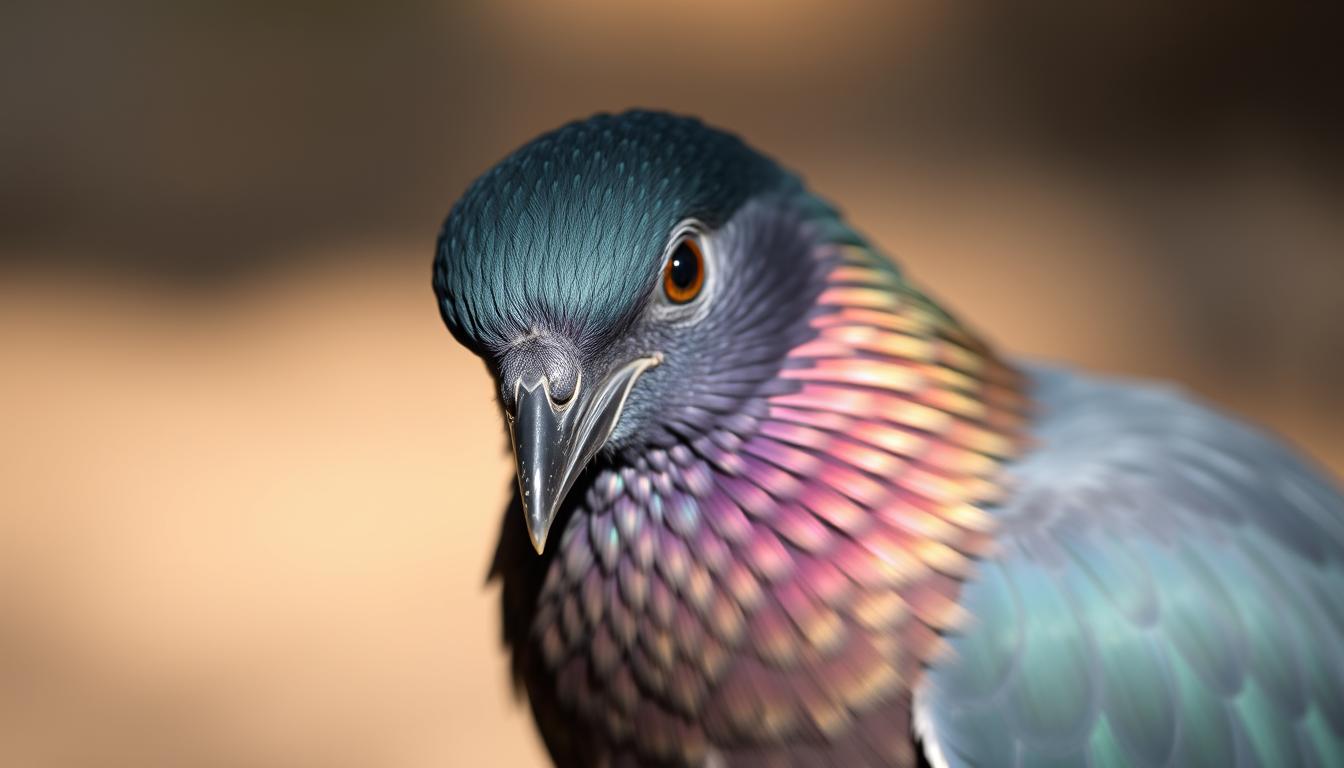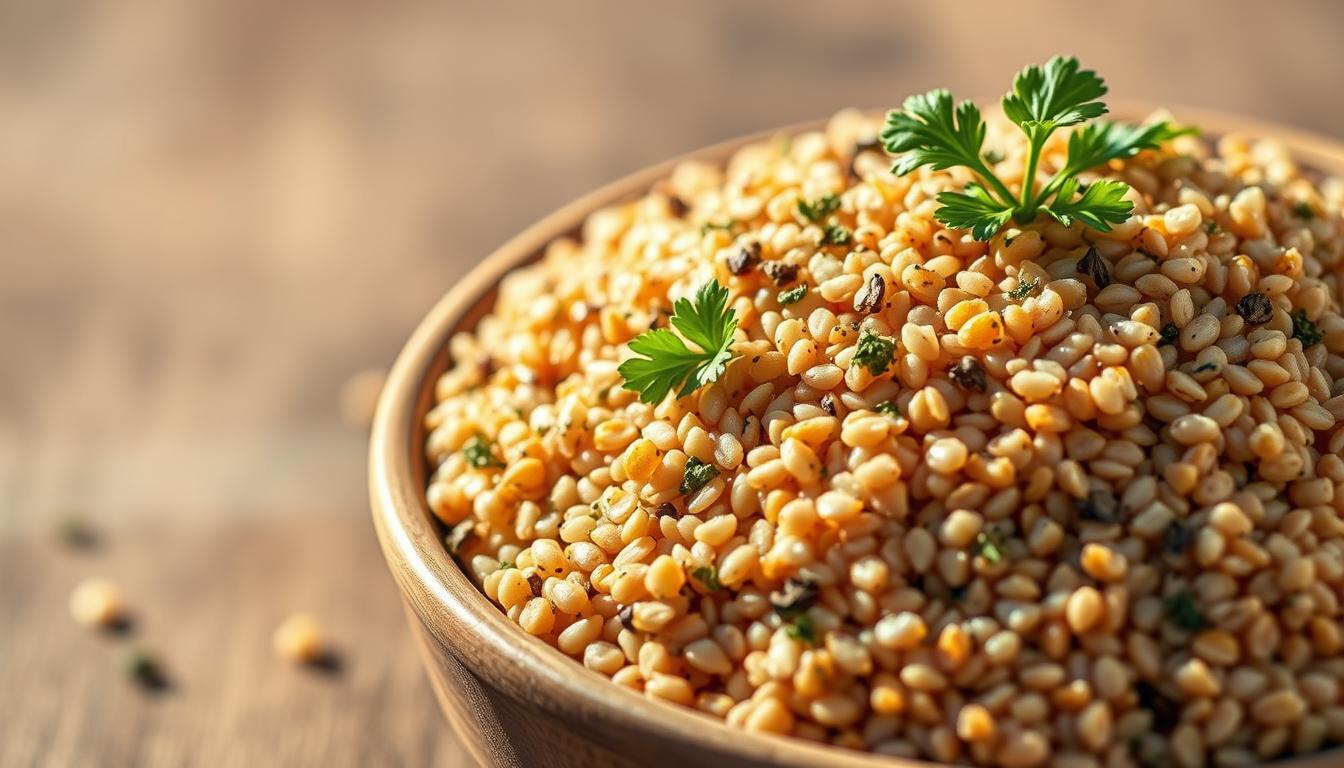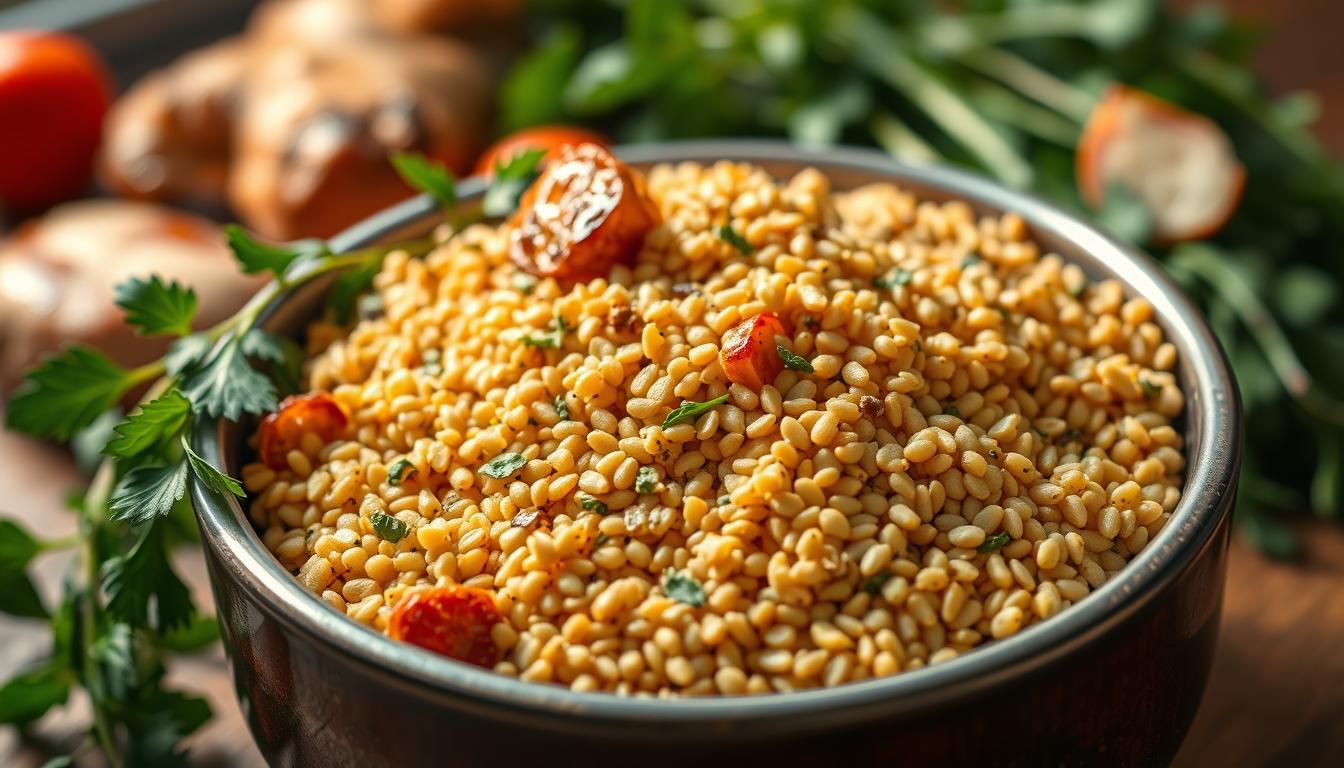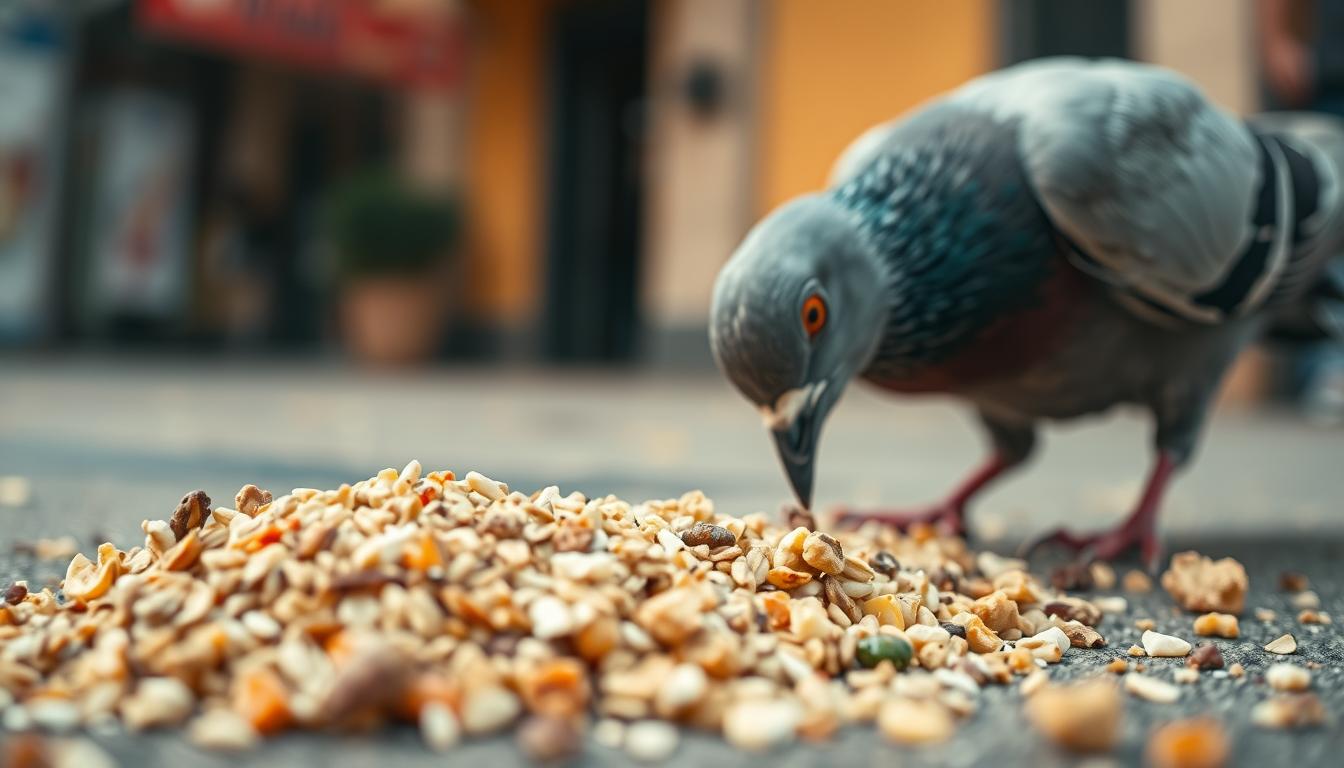Did you know one bird species could reveal secrets of a long-lost creature? The Nicobar pigeon (Caloenas nicobarica) is like a time machine. It connects us to the legendary dodo bird that disappeared long ago.
This bird is more than just a species. It’s a bridge to our past. As the dodo’s closest living relative, the Nicobar pigeon holds secrets of bird evolution and survival.
The Nicobar pigeon is not like the pigeons you see in cities. It’s rare and faces big challenges. Its unique traits and small numbers make it a key focus for saving wildlife.
Table of Contents
Key Takeaways
- The Nicobar pigeon is the closest living relative to the extinct dodo
- This endangered bird species plays a crucial role in understanding evolutionary biology
- Habitat loss threatens the survival of this unique pigeon
- Conservation efforts are critical for protecting this rare species
- The Nicobar pigeon represents a living connection to prehistoric bird populations
Discovering the Last Living Relative of the Dodo
The Nicobar pigeon is a key link to the famous dodo. It carries secrets of the dodo’s past. Scientists find it fascinating for studying evolution.
Studies show the Nicobar pigeon and dodo are closely related. They share a deep connection in bird evolution. This makes them important for understanding bird history.
Evolutionary Connections Unveiled
Genetic studies have shed light on their shared history. The Nicobar pigeon is in the Columbidae family, just like the dodo. Key findings include:
- Closest living genetic relative to the dodo
- Shared ancestral characteristics
- Remarkable preservation of ancient genetic markers
Physical Similarities Explored
The Nicobar pigeon looks different from the dodo, but shares some traits. Studies show they have similar body structures. This gives us clues about the dodo’s appearance.
Genetic Family Tree Insights
Scientists have mapped the genetic ties between these birds. The Nicobar pigeon is like a living fossil. It keeps alive the genetic legacy of the dodo.
| Characteristic | Dodo | Nicobar Pigeon |
|---|---|---|
| Family | Columbidae | Columbidae |
| Estimated Extinction | 1662 | Extant |
| Genetic Proximity | N/A | Closest Living Relative |
Learning about the Nicobar pigeon opens a new chapter in biology. It connects the past and present through this remarkable bird.
Nicobar Pigeon Caloenas Nicobarica: A Unique Species Profile
The Nicobar pigeon is a remarkable bird with unique features. It is found in the Nicobar and Andaman Islands. This bird is one of the most interesting in the Columbidae family.
This bird has special traits that make it stand out. With about 250 pigeon species worldwide, it has remarkable qualities:
- Iridescent plumage with metallic-like sheen
- Primarily found in Southeast Asian island regions
- Monogamous breeding behavior
- Specialized fruit and seed diet
Studies show the Nicobar pigeon is part of the Treroninae subfamily. This subfamily has about 115 species across Africa, southern Asia, Australia, and Pacific islands. Its population is at risk, making it important for conservation.
These pigeons have interesting ways of reproducing. Pairs mate for life, with eggs incubated for 14 to 19 days. The young stay in the nest for 12 to 18 more days. This shows advanced parental care in the Andaman Islands.
The Nicobar pigeon represents a living testament to the incredible diversity of avian life in island environments.
Stunning Physical Characteristics and Metallic Plumage
The Nicobar pigeon is a true marvel of avian beauty. It captures the imagination with its extraordinary physical features. This green pigeon species showcases nature’s artistic brilliance through its remarkable metallic plumage that shimmers with breathtaking iridescence.
Discover the unique characteristics that make this bird a visual spectacle in the animal kingdom:
- Approximate length of 40 cm (16 inches)
- Dark gray body with striking metallic plumage
- Short white tail creating dramatic visual contrast
- Thick, hooked beak designed for seed and fruit consumption
Distinctive Color Patterns
The Nicobar pigeon’s color palette is nothing short of extraordinary. Its neck and head radiate with an iridescent mix of blues, greens, and copper tones. These colors seem to change subtly with movement. This metallic plumage serves not just aesthetic purposes but also plays crucial roles in camouflage and communication.
Size and Body Structure
Larger than many typical pigeon species, the Nicobar pigeon boasts a robust build. This reflects its adaptation to island environments. Its muscular physique supports impressive flight capabilities and survival strategies.
Sexual Dimorphism Features
Males and females of this green pigeon species display subtle differences in their plumage intensity. While both exhibit stunning metallic colors, males often showcase more vibrant and pronounced iridescent feathers during mating seasons.
| Physical Characteristic | Male Nicobar Pigeon | Female Nicobar Pigeon |
|---|---|---|
| Plumage Intensity | More Vibrant | Slightly Muted |
| Color Range | Broader Metallic Spectrum | More Subdued Tones |
| Neck Iridescence | Highly Pronounced | Less Intense |
Natural Habitat and Geographic Distribution
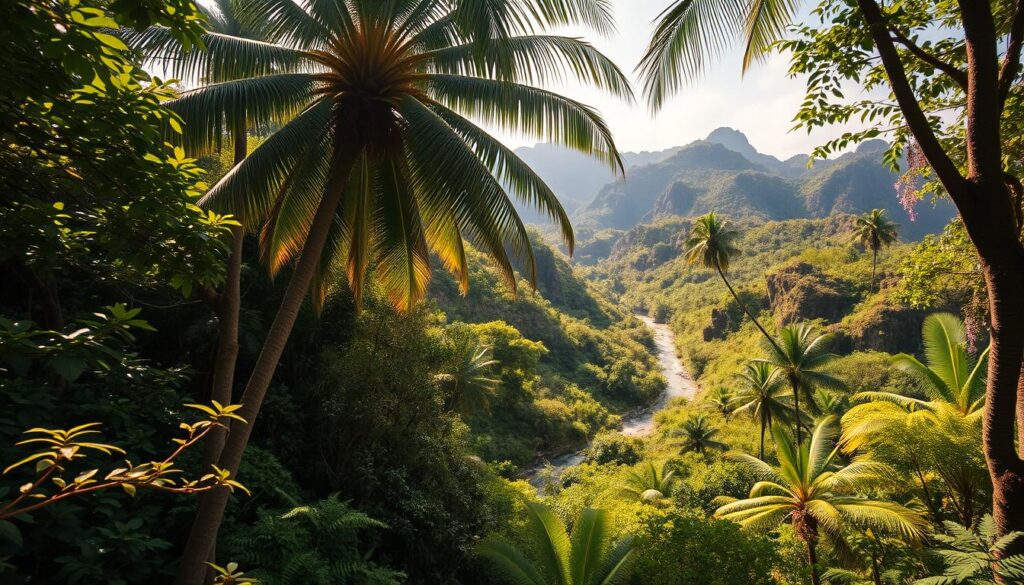
The Nicobar Pigeon lives in the tropical lands of Southeast Asia. It loves the remote islands of the Nicobar and Andaman archipelagos. This is different from urban pigeons that live in cities.
These birds are found in several key places:
- Nicobar Islands
- Andaman Islands
- Small islands in the Indian Ocean
- Coastal regions of Southeast Asian countries
As a ground-dwelling pigeon, it has adapted well to forests and coasts. Its home includes:
- Dense tropical forests
- Coastal woodland areas
- Remote island ecosystems
- Places with little human activity
This species has a unique place in nature. With about 250 pigeon species worldwide, the Nicobar Pigeon is special because of its specific needs.
| Habitat Characteristic | Description |
|---|---|
| Elevation Range | Sea level to moderate forest elevations |
| Climate Preference | Tropical and subtropical regions |
| Ecosystem Type | Dense forest and coastal woodland |
Knowing where the Nicobar Pigeon lives is key for saving it. We must protect its island homes from harm caused by humans.
Advanced Navigation and Flight Capabilities
The Nicobar Pigeon is known for its amazing flight and navigation skills. These skills help it travel between islands with ease. It’s a true marvel among pigeon species.
Pigeons have always amazed scientists with their navigation skills. The Nicobar Pigeon stands out with its incredible flight abilities.
Flight Speed and Distance Records
These birds can fly really fast and cover long distances:
- Maximum flight speed up to 60 miles per hour
- Daily flight distances reaching 600 miles
- Sustained flight for several hours without stopping
- Typical flying altitude around 6,000 feet
Unique Navigational Abilities
The Nicobar Pigeon’s navigation is truly unique. It uses many cues to cross vast oceans, including:
- Magnetic field detection
- Solar positioning
- Landmark recognition
- Celestial navigation
Migration Patterns
Migration is key for these pigeon species. It’s influenced by seasons, food, and breeding. The Nicobar Pigeon’s migrations help keep island ecosystems diverse.
The intricate flight capabilities of the Nicobar Pigeon represent a remarkable adaptation to its complex island environment.
Breeding Habits and Population Growth
The Nicobar Pigeon is a key example of endangered birds. It has unique breeding habits that make conservation tough. Female pigeons can start breeding at just 7 months old. This means they can have many breeding seasons.
They have special ways of breeding that differ from other pigeons:
- Mating for life with strong pair bonding
- Producing 1-2 eggs per clutch
- Incubation period spanning approximately 18 days
- Chick development requiring intense parental care
The survival of these birds depends on successful breeding. They face challenges like limited space and threats to their homes. Their young need a lot of care, making it hard to grow their numbers.
Studies show very few birds left in the wild, between 70-380. This situation highlights the need for urgent conservation efforts. We must protect their homes and help them breed successfully.
Preserving the Nicobar Pigeon means safeguarding not just a species, but a living connection to evolutionary history.
Learning about their breeding habits is key to keeping these birds alive. It helps us understand how to protect them.
Conservation Status and Current Threats
The Nicobar Pigeon is in a tough spot, being one of the most endangered birds. It needs help from wildlife experts and groups that care about the environment.
The species is listed as Near Threatened. Several big threats are making it hard for them to survive.
Habitat Loss Impact
Deforestation is a big problem for the Nicobar Pigeon. The growth of palm oil plantations is cutting down their homes. This makes life very hard for these special birds.
- Over 60% of original forest areas have been transformed
- Continuous land clearing destroys nesting grounds
- Fragmentation of forest ecosystems limits breeding opportunities
Human Activity Effects
People’s actions are a big danger to the Nicobar Pigeon. Hunting, illegal pet trade, and messing with their environment are big problems.
Predator Pressures
Introduced predators are a big threat to the Nicobar Pigeon. Rats and feral cats are hunting them, making it hard for them to survive.
| Threat Category | Impact Level | Population Reduction Estimate |
|---|---|---|
| Habitat Loss | High | 25-40% |
| Hunting | Medium | 10-20% |
| Predation | High | 15-30% |
These threats show we need to act fast to save the Nicobar Pigeon. We must work together to keep this amazing bird from disappearing.
Role in Island Ecosystems
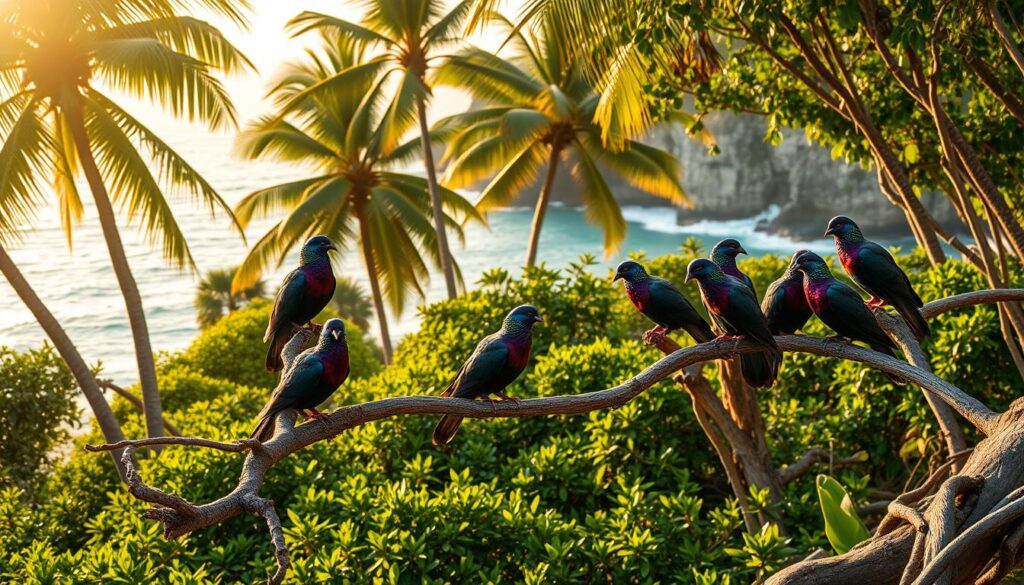
The Nicobar Pigeon is a key species in the island ecosystems of the Andaman and Nicobar archipelago. These birds are vital for keeping their habitats in balance. They help in forest growth and play a big role in the ecosystem.
As a ground-dwelling bird, the Nicobar Pigeon spreads seeds across the islands. This helps plants grow and keeps the biodiversity rich.
- Essential seed dispersal agent for island flora
- Supports forest ecosystem regeneration
- Contributes to maintaining ecological balance
The bird is important in the food chain. Predators rely on them for food. This shows how each species is connected and important for survival.
| Ecosystem Function | Impact Level |
|---|---|
| Seed Dispersal | High |
| Prey for Predators | Medium |
| Forest Regeneration | High |
“In the intricate web of island life, every species has a story, and the Nicobar Pigeon writes its chapter with remarkable ecological precision.” – Wildlife Conservationist
It’s crucial to protect these pigeons. Losing them could harm the whole ecosystem. Saving them helps keep the islands healthy and balanced.
Conservation Efforts and Future Prospects
Endangered birds like the Nicobar Pigeon need strong conservation plans. International groups are leading the way with new methods to save these birds from extinction.
Experts have set up several plans to protect birds:
- Habitat restoration projects in key island areas
- Captive breeding programs to keep genetic diversity
- Legal protections for endangered birds
- Public campaigns to raise awareness about wildlife
The ASEAN Heritage Parks network has grown from 11 to 62 sites, covering 11.6 million hectares. This growth is crucial for protecting birds like the Nicobar Pigeon, which is currently Near Threatened.
“Protecting endangered birds requires collaborative global efforts and sustained commitment to conservation,” says Dr. Elena Rodriguez, Wildlife Conservation Specialist.
Habitat loss, hunting, and climate change are big challenges. About 25% of bird species face major threats from these issues.
But, there’s hope with new tech and global teamwork. Projects like eBird are getting thousands involved in bird conservation. This gives us hope for these vulnerable birds.
| Conservation Strategy | Impact Level |
|---|---|
| Habitat Protection | High |
| Breeding Programs | Medium |
| Public Awareness | Medium-High |
Your support and awareness can greatly help protect these amazing birds and our planet’s biodiversity.
Conclusion
The Nicobar pigeon Caloenas nicobarica is more than just a bird. It shows us the importance of the Andaman and Nicobar Islands’ ecosystem. With over 270 bird species, these islands are a delicate balance. Learning about this bird can help us save it and its home.
Protecting the Nicobar pigeon is key to keeping the islands’ biodiversity alive. The islands are covered in 86% lush vegetation, home to many species. Saving this bird means protecting a whole ecosystem, including marine and terrestrial life.
Your efforts can really help. By supporting research and protecting habitats, you can prevent the Nicobar pigeon from disappearing. Every action to understand and protect this bird helps keep the islands’ ecological balance.
Protecting the Nicobar pigeon is not just about saving a bird. It’s about preserving the amazing web of life on Earth. By fighting for this bird, you join a global effort to protect our planet.
FAQ
What is the Nicobar Pigeon?
The Nicobar Pigeon is a unique bird found in the Nicobar and Andaman Islands. It has stunning iridescent feathers. It’s one of the most unique pigeons, closely related to the extinct dodo.
Why is the Nicobar Pigeon considered endangered?
It faces threats like habitat loss and hunting. Its island home and ground-dwelling nature make it vulnerable. These factors harm its survival.
How is the Nicobar Pigeon related to the dodo?
Studies show the Nicobar Pigeon is the dodo’s closest living relative. They share genetic and physical traits. This makes the Nicobar Pigeon key to understanding bird evolution.
What makes the Nicobar Pigeon’s appearance unique?
Its feathers shine in metallic green, blue, and copper. This is unlike other pigeons. Its looks and features make it stand out.
Where do Nicobar Pigeons live?
They live on small islands in the Indian Ocean. They like forests and coasts. Their ground-dwelling lifestyle is different from other pigeons.
How do Nicobar Pigeons contribute to their ecosystem?
They help spread seeds in island ecosystems. Their habits and diet keep forests healthy. This supports biodiversity and ecological balance.
What are the conservation efforts for Nicobar Pigeons?
Efforts include restoring habitats and breeding programs. Legal protections and international cooperation are also key. These actions aim to protect the species and its habitat.
Can Nicobar Pigeons be found in zoos or wildlife conservation centers?
Yes, some zoos and centers breed Nicobar Pigeons. These programs help study and preserve the species. They also support efforts to recover the population.
Source Links
- Dodo – https://en.wikipedia.org/wiki/Dodo
- Fascinating Pigeon Facts and Figures: 2024 Insights – https://www.ovocontrol.com/pigeon-facts-figures?srsltid=AfmBOooV53J_kXQ3QjkXTMuQqQ3ztHgbSFJr__Sjt-2g4fMSdYTVVup1
- Dodo (Raphus cucullatus): When and why did it go extinct – https://planetofbirds.com/dodo-raphus-cucullatus/
- 3 Amazing Facts You Should Know About The Dodo – https://medium.com/cognitive-creatures/3-amazing-facts-you-should-know-about-the-dodo-a7c4196e5aa3
- Pigeon | Bird of Prey, Flight & Migration Patterns | Britannica – https://www.britannica.com/animal/pigeon
- Nicobar pigeon facts, distribution & population | BioDB – https://biodb.com/species/nicobar-pigeon/
- Rare Indian Birds: What Makes Them Unique? – Wildlife & Ecosystem Explorations – https://ecovegetation.com/unique-rare-indian-birds/
- Fascinating Pigeon Facts and Figures: 2024 Insights – https://www.ovocontrol.com/pigeon-facts-figures?srsltid=AfmBOoobbqXO0z5fP26H8bspQGDMErq7QKpb5psw_hYXcYXEi44zQStZ
- The importance of migratory drop-off for island colonization in birds – https://pmc.ncbi.nlm.nih.gov/articles/PMC11021927/
- Fascinating Pigeon Facts and Figures: 2024 Insights – https://www.ovocontrol.com/pigeon-facts-figures?srsltid=AfmBOorAdOEk_wPWXZtLTp0DrvvE-37-jiK9ttS5P4-h6jjHWizWWsox
- Tooth-billed pigeon – https://en.wikipedia.org/wiki/Tooth-billed_pigeon
- Papua New Guinea: Species Endangered by Palm Oil Deforestation – Palm Oil Detectives – https://palmoildetectives.com/tag/papua-new-guinea-species-endangered-by-palm-oil-deforestation/
- Dodo (Raphus cucullatus): Extinct Bird Species 17th century – https://www.species-extinction.com/dodo/
- Flora and Fauna of Andaman and Nicobar Islands – https://www.sostravelhouse.com/travelogue/flora-and-fauna-of-andaman-and-nicobar-islands
- 10 Native only to India Bird Species Which Exists Here – https://medium.com/@fakharhayaat42/10-native-only-to-india-bird-species-which-exists-here-131d1fce8710
- AHP@40: ACB welcomes 5 new ASEAN Heritage Parks – ASEAN Centre for Biodiversity – https://www.aseanbiodiversity.org/news-events-jobs/ahp40-acb-welcomes-5-new-asean-heritage-parks/
- 10 Bird Species That are Mainly Found in India – https://www.petanimalshub.com/bird-species-that-are-mainly-found-in-india/

